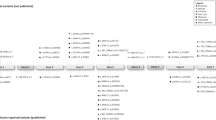Abstract
Neuronal ceroid lipofuscinoses (NCLs) are autosomal recessive neurodegenerative disorders typically characterized by the accumulation of autofluorescent material in tissues. On the basis of clinical features, age at onset, and molecular genetic defects, it is possible to distinguish at least nine forms. The CLN8 form was first described in Finland, where all the patients are homozygous for a p.Arg24Gly mutation in CLN8. More recently, it has been found that a subset of a Turkish variant of late infantile NCL (v-LINCL) is also associated with CLN8 mutations. To identify the molecular defect in Italian patients with v-LINCL, the CLN8 gene was directly sequenced in 10 patients. Controls were screened by polymerase chain reaction-restriction fragment length polymorphism (PCR-RFLP) analysis. Five fluorescent-labeled microsatellite markers covering 1 cM around the gene were used for haplotype analysis. In three Italian v-LINCL patients, identified in a small area in southern Italy, we detected four new mutations in CLN8: c.66delG (p.Gly22fs), c.88G>C (p.Ala30Pro), c.473A>G (p.Tyr158Cys), and c.581A>G (p.Gln194Arg). The single-base deletion was found in two unrelated patients. The novel missense mutations were not identified in ethnically matched control chromosomes. Our findings expand the number of CLN8 variants and corroborate the notion that CLN8 patients are not confined to the Finnish population.



Similar content being viewed by others
References
Mole SE, Williams RE, Goebel HH (2005) Correlations between genotype, ultrastructural morphology and clinical phenotype in the neuronal ceroid lipofuscinoses. Neurogenetics 6:107–126
Weimer JM, Kriscenski-Perry E, Elshatory Y, Pearce DA (2002) The neuronal ceroid lipofuscinoses: mutations in different proteins result in similar disease. Neuromolecular Med 1:111–124
Haltia M (2003) The neuronal ceroid-lipofuscinoses. J Neuropathol Exp Neurol 62:1–13
Cardona F, Rosati E (1995) Neuronal ceroid-lipofuscinoses in Italy: an epidemiological study. Am J Med Genet 57:142–143
Schulz A, Dhar S, Rylova S, Dbaibo G, Alroy J, Hagel C, Artacho I, Kohlschutter A, Lin S, Boustany RM (2004) Impaired cell adhesion and apoptosis in a novel CLN9 Batten disease variant. Ann Neurol 56:342–350
Wisniewski KE, Golabek AA, Kida E (2004) Rare forms of neuronal ceroid lipofuscinoses. In: Golden JA, Harding BN (eds) Developmental neuropathology. Pathology & genetics. ISN Neuropath, Basel, pp 109–113
Goebel HH, Wisniewski KE (2004) Current state of clinical and morphological features in human NCL. Brain Pathol 14:61–69
Hirvasniemi A, Lang H, Lehesjoki AE, Leisti J (1994) Northern epilepsy syndrome: an inherited childhood onset epilepsy with associated mental deterioration. J Med Genet 31:177–182
Herva R, Tynnela J, Hirvasniemi A, Syrjakallio M, Haltia M (2000) Northern epilepsy: a novel form of neuronal ceroid-lipofuscinosis. Brain Pathol 10:215–222
Ranta S, Zhang Y, Ross B, Lonka L, Takkunen E, Messer A, Sharp J, Wheeler R, Kusumi K, Mole S, Liu W, Soares MB, Bonaldo MF, Hirvasniemi A, de la Chapelle A, Gilliam TC, Lehesjoki AE (1999) The neuronal ceroid lipofuscinoses in human EPMR and mnd mutant mice are associated with mutations in CLN8. Nat Genet 23:233–236
Mitchell WA, Wheeler RB, Sharp JD, Bate SL, Gardiner RM, Ranta US, Lonka L, Williams RE, Lehesjoki AE, Mole SE (2001) Turkish variant late infantile neuronal ceroid lipofuscinosis (CLN7) may be allelic to CLN8. Eur J Paediatr Neurol 5(Suppl A):21–27
Topcu M, Tan H, Yalnizoglu D, Usubutun A, Saatci I, Aynaci M, Anlar B, Topaloglu H, Turanli G, Kose G, Aysun S (2004) Evaluation of 36 patients from Turkey with neuronal ceroid lipofuscinosis: clinical, neurophysiological, neuroradiological and histopathologic studies. Turk J Pediatr 46:1–10
Ranta S, Topcu M, Tegelberg S, Tan H, Ustubutun A, Saatci I, Dufke A, Enders H, Pohl K, Alembik Y, Mitchell WA, Mole SE, Lehesjoki AE (2004) Variant late infantile neuronal ceroid lipofuscinosis in a subset of Turkish patients is allelic to Northern epilepsy. Hum Mutat 23:300–305
Lonka L, Kyttala A, Ranta S, Jalanko A, Lehesjoki AE (2000) The neuronal ceroid lipofuscinosis CLN8 membrane protein is a resident of the endoplasmic reticulum. Hum Mol Genet 9:1691–1697
Lonka L, Salonen T, Siintola E, Kopra O, Lehesjoki AE, Jalanko A (2004) Localization of wild-type and mutant neuronal ceroid lipofuscinosis CLN8 proteins in non-neuronal and neuronal cells. J Neurosci Res 76:862–871
Winter E, Ponting CP (2002) TRAM, LAG1 and CLN8: members of a novel family of lipid-sensing domains? Trends Biochem Sci 27:381–383
Katz ML, Khan S, Awano T, Shahid SA, Siakotos AN, Johnson GS (2005) A mutation in the CLN8 gene in English setter dogs with neuronal ceroid-lipofuscinosis. Biochem Biophys Res Commun 327:541–547
Teixeira C, Guimaraes A, Bessa C, Ferreira MJ, Lopes L, Pinto E, Pinto R, Boustany RM, Sa Miranda MC, Ribeiro MG (2003) Clinicopathological and molecular characterization of neuronal ceroid lipofuscinosis in the Portuguese population. J Neurol 250:661–667
Acknowledgements
The authors acknowledge the contribution of Mrs. C.J. Wrenn in editing and revising the manuscript. The skillful technical assistance with electron microscopy of Mrs. Floriana Gismondi is also appreciated. Research in our laboratories is supported by grants from MIUR (Cofinanziamento 2003), the Italian Superior Health Institute (FMS), and the Italian Ministry of Health (Ricerca corrente, strategica, finalizzata 2003, grant no. 132/03 to F.Z.). FMS and NC thank the families for their active participation in this project.
Author information
Authors and Affiliations
Corresponding author
Electronic supplementary materials
Below is the link to the electronic supplementary material.
Table 1
Oligonucleotide primers used to amplify the coding sequence of CLN8 (NT_023736.16) (PDF 53 kb)
Rights and permissions
About this article
Cite this article
Cannelli, N., Cassandrini, D., Bertini, E. et al. Novel mutations in CLN8 in Italian variant late infantile neuronal ceroid lipofuscinosis: another genetic hit in the Mediterranean. Neurogenetics 7, 111–117 (2006). https://doi.org/10.1007/s10048-005-0024-y
Received:
Accepted:
Published:
Issue Date:
DOI: https://doi.org/10.1007/s10048-005-0024-y




